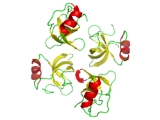
Hydrophobin
Encyclopedia
Hydrophobins are a class of small, cysteine
rich proteins (~ 100 amino acids) that are expressed only by filamentous fungi
. They are known for their capability of forming a hydrophobic
(water-repellent) coating on a surface of an object. They were first discovered and separated in Schizophyllum commune
in 1991. Based on differences in hydropathy patterns and biophysical
properties, they are divided into two categories: class I and class II. Hydrophobins can self-assemble into monolayer on hydrophobic:hydrophilic interfaces, such as water:air interface. Class I monolayer contains the same core structure as amyloid fibrils, which is positive to Congo red and thioflavin T. Monolayer formed by class I hydrophobins has highly ordered structure, and they can only be dissociated by neat trifluoroacetate or formic acid.
Fungi make complex aerial structures and spores even in aqueous environments.
Hydrophobins have been identified in ascomycetes and basidiomycetes; whether they exist in other groups is not known. Hydrophobins are generally found on the outer surface of conidia
and of the hyphal
wall, and may be involved in mediating contact and communication between the fungus and its environment. Some family members contain multiple copies of the domain.
This family of poteins
includes the rodlet proteins
of Neurospora crassa
(gene eas) and Emericella nidulans (gene rodA), these proteins are the main component of the hydrophobic sheath covering the surface of many fungal spores.
Cysteine
Cysteine is an α-amino acid with the chemical formula HO2CCHCH2SH. It is a non-essential amino acid, which means that it is biosynthesized in humans. Its codons are UGU and UGC. The side chain on cysteine is thiol, which is polar and thus cysteine is usually classified as a hydrophilic amino acid...
rich proteins (~ 100 amino acids) that are expressed only by filamentous fungi
Mold
Molds are fungi that grow in the form of multicellular filaments called hyphae. Molds are not considered to be microbes but microscopic fungi that grow as single cells called yeasts...
. They are known for their capability of forming a hydrophobic
Hydrophobe
In chemistry, hydrophobicity is the physical property of a molecule that is repelled from a mass of water....
(water-repellent) coating on a surface of an object. They were first discovered and separated in Schizophyllum commune
Schizophyllum commune
Schizophyllum commune is a very common species of mushroom in the genus Schizophyllum. It is the world's most widely distributed mushroom, occurring on every continent except Antarctica....
in 1991. Based on differences in hydropathy patterns and biophysical
Biophysics
Biophysics is an interdisciplinary science that uses the methods of physical science to study biological systems. Studies included under the branches of biophysics span all levels of biological organization, from the molecular scale to whole organisms and ecosystems...
properties, they are divided into two categories: class I and class II. Hydrophobins can self-assemble into monolayer on hydrophobic:hydrophilic interfaces, such as water:air interface. Class I monolayer contains the same core structure as amyloid fibrils, which is positive to Congo red and thioflavin T. Monolayer formed by class I hydrophobins has highly ordered structure, and they can only be dissociated by neat trifluoroacetate or formic acid.
Fungi make complex aerial structures and spores even in aqueous environments.
Hydrophobins have been identified in ascomycetes and basidiomycetes; whether they exist in other groups is not known. Hydrophobins are generally found on the outer surface of conidia
Conidium
Conidia, sometimes termed conidiospores, are asexual, non-motile spores of a fungus and are named after the greek word for dust, konia. They are also called mitospores due to the way they are generated through the cellular process of mitosis...
and of the hyphal
Hypha
A hypha is a long, branching filamentous structure of a fungus, and also of unrelated Actinobacteria. In most fungi, hyphae are the main mode of vegetative growth, and are collectively called a mycelium; yeasts are unicellular fungi that do not grow as hyphae.-Structure:A hypha consists of one or...
wall, and may be involved in mediating contact and communication between the fungus and its environment. Some family members contain multiple copies of the domain.
This family of poteins
Protein family
A protein family is a group of evolutionarily-related proteins, and is often nearly synonymous with gene family. The term protein family should not be confused with family as it is used in taxonomy....
includes the rodlet proteins
Protein
Proteins are biochemical compounds consisting of one or more polypeptides typically folded into a globular or fibrous form, facilitating a biological function. A polypeptide is a single linear polymer chain of amino acids bonded together by peptide bonds between the carboxyl and amino groups of...
of Neurospora crassa
Neurospora crassa
Neurospora crassa is a type of red bread mold of the phylum Ascomycota. The genus name, meaning "nerve spore" refers to the characteristic striations on the spores. The first published account of this fungus was from an infestation of French bakeries in 1843. N...
(gene eas) and Emericella nidulans (gene rodA), these proteins are the main component of the hydrophobic sheath covering the surface of many fungal spores.

